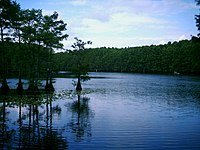South Central United States

The South Central United States or South Central states is a region of the United States located in the south central part of the country. It evolved out of the archaic southwest, which originally was literally the western U.S. South. The states of Arkansas, Louisiana, Oklahoma, and Texas (which make up the Census Bureau Division called West South Central States) are always included in the region; sometimes Kansas, Mississippi, Missouri, and New Mexico are included. All of the region is in the Central United States, though all of the South Central states were considered part of the West, at different points in American history.
Geography

The climate varies from the semi-tropical Mississippi Delta in South Louisiana to the dry Chihuahuan desert in West Texas and southern New Mexico. The southeastern portions include the Piney Woods of East Texas, Louisiana, and southern Arkansas and the Mississippi Delta. Large portion of the northeastern quarter of the region is mountainous, with the Ozark and Ouachita Mountains of Arkansas and eastern Oklahoma. The northwest quarter of the region is dominated by the Great Plains which become progressively drier west of 100° W, forming the North American Llano. The southwestern portions border the Rio Grande, and are generally drier that other areas of the South Central United States, Central Texas having the most annual precipitation.
Texas is the largest South Central state by both area and population—even when New Mexico and Mississippi are included, Texas is still home to over half the region's population. The five largest cities in the region—Houston, San Antonio, Dallas, Austin, and Fort Worth—are all located in Texas. Outside of Texas, the largest metropolitan area is Oklahoma City, which in 2005 had a population of over 1.24 million. New Orleans was tied with Oklahoma City but, after Hurricane Katrina, the population of the New Orleans metro area has declined to approximately 900,000 (a survey shows that the population has bounced back to almost 1.2 million as of April 2007). Oklahoma City, with a population of 553,000, is the largest central city in the region outside of the aforementioned cities in Texas.
History
The history of the South Central states is dominated by the conflict and interaction between three cultural-linguistic groups: the Anglosphere (first Great Britain and then the United States), the Hispanidad (first Spain then Mexico), and the Francophonie (always France). In the 17th and 18th centuries Spain and France maneuvered for control of Texas, with the Spanish based in Mexico and New Mexico and the French in Louisiana. During the War of the Quadruple Alliance hostilities spread to the New World and the French troops from Natchitoches briefly captured the capital of Spanish Texas, Los Adaes in what is now western Louisiana. The French were not able to wrest control of Texas from Spain, and by the early 19th century sold their North American holdings to the United States in the Louisiana Purchase, which comprised slightly less than half of what is today the South Central United States.
